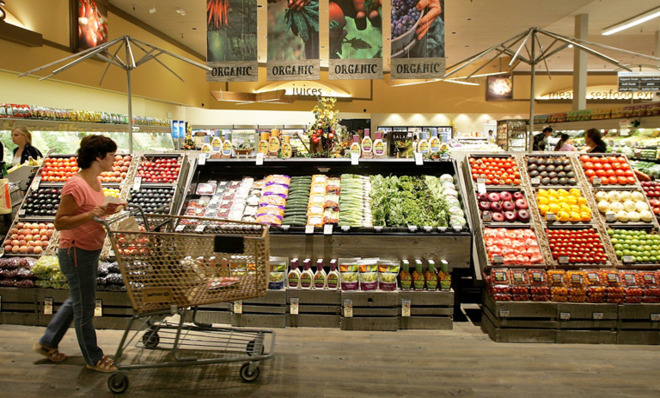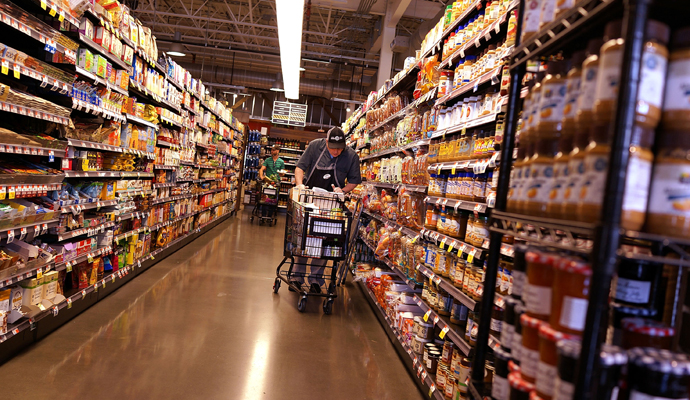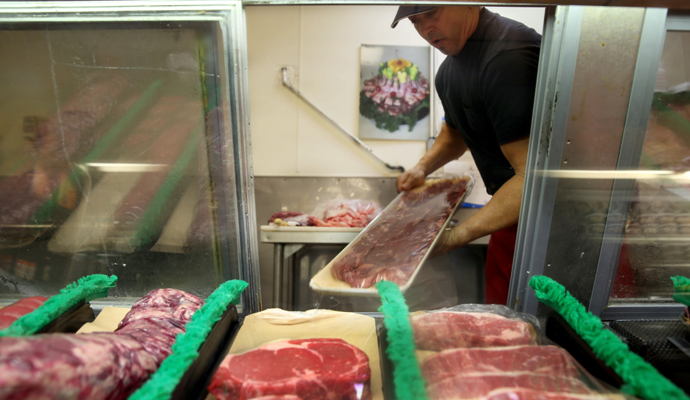10 ways to manage your grocery bill in the face of rising food costs
Make Wednesday shopping night


As the heat index rises, so will your grocery bill this summer.
It's all thanks to Mother Nature, who has been doing a number on our food supply. Ongoing droughts have bumped up prices for produce and produced a trickle-down effect on meat, since feeding cattle has become costlier. At the same time, a virus has been plaguing pigs across the nation, spiking prices on pork.
It's not a pretty picture just as barbecue season goes into full swing. But you can still find ways to grocery shop on a budget, especially if you know where to expect the hikes.
The Week
Escape your echo chamber. Get the facts behind the news, plus analysis from multiple perspectives.

Sign up for The Week's Free Newsletters
From our morning news briefing to a weekly Good News Newsletter, get the best of The Week delivered directly to your inbox.
From our morning news briefing to a weekly Good News Newsletter, get the best of The Week delivered directly to your inbox.
So we tapped an agricultural economist to help us figure out which food prices will be on the uptick — and then asked a pair of consumer experts for tips and tricks on how to keep spending down on summer food staples.
Grocery price creep: Which foods will cost more?
If your backyard barbecue normally includes a few T-bones and filet mignons, you may have to rethink picking up those pricey cuts. According to Dr. Christopher Hurt, an agricultural economist at Purdue University, beef supplies are expected to drop 5 percent in 2014 — and the number of beef cow herds is at its lowest since 1962. Add to that a five-year drought in the central and southern plains that raised cattle feed prices, and you have a recipe for a costly steak.
"Retail beef prices at grocery stores averaged a record $5.29 per pound in 2013," Hurt says. "I expect that to be $5.63 a pound this year — nearly a 7 percent increase."
A free daily email with the biggest news stories of the day – and the best features from TheWeek.com
O.K., so you'll just throw some hot dogs on the grill instead. Not so fast. A porcine virus has resulted in the deaths of more than 6 million young pigs since it was identified in 2013. "Last year, [pork] prices were $3.64 a pound," Hurt says. "I expect those to average $3.90 a pound this year, which is also a 7 percent increase."
In fact, animal proteins overall have seen high cost increases this year. The most recent data for March 2014 shows this category was up 5.1 percent, compared with the same time last year. Eggs, in particular, are seeing a big jump in prices, which were up almost 10 percent, partly due to large export volumes to Mexico — which experienced an avian flu outbreak — that have squeezed the U.S. supply.
Vegetarians aren't immune from wallet-squeezing this summer, either. An ongoing drought in California is impacting almost every type of fruit and veggie that makes it to your dinner plate.
According to a recently released Arizona State University study, nine types of produce are likely to see a serious price hike this summer: lettuce (at a whopping 34 percent increase!), avocados, broccoli, grapes, tomatoes, melons, peppers, berries, and corn. Packaged salads are also expected to jump by 13 percent.
In addition to the drought, the growing season has had a slower start due to cooler and wetter than normal weather. And Hurt suspects this could impact grains and oilseeds, which could affect prices for cereals, baked goods, and vegetable oils.
Bottom line for your grocery budget? The USDA expects your food costs will go up 2.8 percent over last year.
How can I keep my grocery bill from ballooning?
Now that you know how much prices might go up, you can still work to keep costs down. These 10 hacks from consumer savings experts can help you have your cake (and pork chops and berries) and eat it too.

1. Make Wednesday your food shopping night. Roughly half of retailers update their sales circulars for the upcoming week on Wednesdays, says Gord Crowson, senior vice president at MyGroceryDeals.com. And if you shop on Wednesday, most of the items on sale will be in stock. Sometimes the sales are even posted a day earlier, he adds, so you can do your homework and prepare your list in advance.
Shopping at night also gives you the added bonus of reduced prices on perishables. Prices tend to drop a few hours before closing, so stores can move product quickly.
"These items are perfectly good, as long as you are going to eat them soon or freeze them," Crowson says. Savings of 50 percent or more are the norm, so you could score a sweet discount on fruit, veggies, meat, seafood, and fresh bakery items.
2. Stock up during deep-discount periods. For meat, look for manager markdowns, suggests consumer savings expert Andrea Woroch, and then buy a lot and freeze what you don't plan to cook right away. According to the USDA, meat can stay in the freezer for up to 12 months. Just make sure to cut it into smaller pieces and then individually wrap them, so you don't have to defrost a whole package at once.
For other foods, if you missed a sale, keep an eye out for another retailer that's having a sale on the same item the following week, suggests Crowson, explaining that temporary price reductions are offered by manufacturers to all retailers in the same area, typically on a monthly basis. Each retailer then decides which week to run the sale.
And always ask for a rain check if the store runs out of a sale item, Crowson says. Unless it's a limited-quantity offer, they'll usually honor the sale price when more stock comes in.
3. Forgo the packaging. The more precut or prepackaged fresh meat and veggies are, the more it's adding to your cost, says Woroch. Fresh meat precut into smaller portions is about 60 percent costlier than buying larger slabs; precut fresh fruits and veggies are 60 percent more expensive than buying them whole.
4. Know when not to shop organic. You pay a premium for that label, but some produce has built-in "protection," which means you don't have to go the organic route if you're worried about pesticides. Bananas, avocado, and pineapple — thanks to their thick, tough skins — fall into this group, notes Woroch. Check out the Environmental Working Group's Clean 15 for more products you can pass over in the organic aisle.
5. Buy the whole cow. If you really want to go whole hog on your beef, consider "cowpooling" — going in with friends or neighbors on an entire animal from a local farm and sharing the butchered cuts of meat. Staying local and buying "in bulk" gives you access to higher quality at lower prices.

6. DIY your produce. The great thing about fruits and veggies is that you can always grow your own. Start small with herbs, suggests Woroch, and don't let space hold you back. Do you lack the backyard real estate? Vegetables like lettuce, tomatoes, summer squash, eggplant, and peppers can just as easily be grown in containers or window boxes.
7. Buy in season. "This allows for savings [because you're purchasing when] products are typically more plentiful and available," Crowson says. A juicy tip: If you're hitting up farmers' markets for locally grown produce, try going toward the end of the day. "[Vendors] don't want to have to pack the items up and haul them back to the farm," he adds.
8. Join community-supported agriculture (CSA) groups. "Basically, you buy a share in a local farm's annual crops and receive boxes containing any combination of fruits, vegetables, eggs, meats, baked goods, herbs, cheese, or flowers," Woroch explains. Some CSAs even set up payment plans, so clients don't have to shell out for their entire share at once. "Community supported agriculture ensures you eat nothing but the freshest food, while saving a surprising amount of money," she adds.
9. Consider frozen foods. "Frozen fruits and veggies are an economical way to get your nutrients during any season," Woroch says. And since produce is flash-frozen at its peak ripeness and nutrient content, there's no need to worry about lack of flavor or healthfulness. For an even better deal, Woroch suggests opting for store brands, as well as shopping at wholesalers like Costco.
10. Buy in bulk. Speaking of Costco, if you have storage space and carefully watch those "best before" dates, says Crowson, buying in bulk is a great way to save. Meat and seafood, in particular, tends to cost less per pound when bought in big quantities.
That said, don't just fill your cupboards and freezer with items you'll forget about or get sick of eating. "The savings evaporate," Crowson says, "when you have to throw out product because it's past its expiry date."
This story was originally published on LearnVest. LearnVest is a program for your money. Read their stories and use their tools at LearnVest.com.
More from LearnVest...
-
 Political cartoons for January 3
Political cartoons for January 3Cartoons Saturday's political cartoons include citizen journalists, self-reflective AI, and Donald Trump's transparency
-
 Into the Woods: a ‘hypnotic’ production
Into the Woods: a ‘hypnotic’ productionThe Week Recommends Jordan Fein’s revival of the much-loved Stephen Sondheim musical is ‘sharp, propulsive and often very funny’
-
 ‘Let 2026 be a year of reckoning’
‘Let 2026 be a year of reckoning’Instant Opinion Opinion, comment and editorials of the day